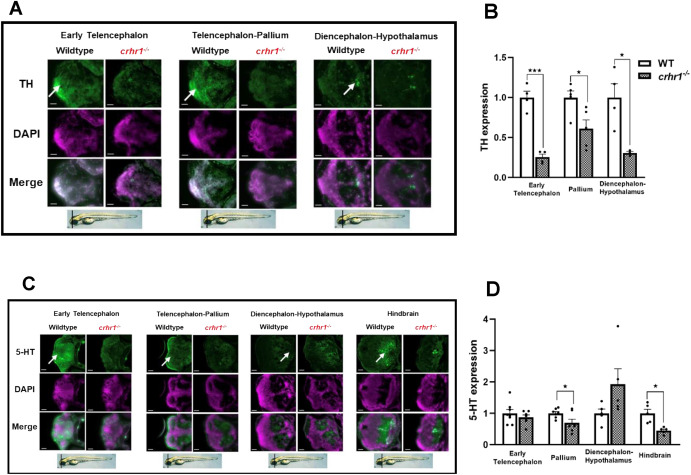Fig. 5 Loss of Crhr1 affects the monoamine system in zebrafish larvae: Representative immunohistochemistry (IHC) labelling (5A and 5C) of cryo-sectioned 4 dpf zebrafish wildtype and crhr1−/− larval brains for tyrosine hydroxylase (TH) (A) and serotonin (5-HT) (C), showing telencephalic (early telencephalon and telencephalon-pallium), diencephalon-hypothalamus, and hindbrain regions of interest (arrows) with altered levels of monoamine distribution between genotypes (scale bar = 50 μm). Zebrafish schematics underneath IHC images indicate relative location of representative brain section, adapted from ZFIN brain atlas (https://zfin.org/zf_info/anatomy.html) and related publication (Kimmel et al., 1995). Middle rows under each section (5A and 5C) represent respective sections stained with nuclear stain DAPI and the bottom rows represents merged images. The images were quantified and the relative intensity of TH (B) and 5-HT (D) expression in different brain regions are shown. Larval brain sections were analyzed in Fiji for the various regions of interest, and the integrated density values used to calculate fold change in intensity relative to wildtype. Bars represent means + SEM (n = 3–8), with values for individuals shown as data points. An asterisk indicates a statistically significant difference between genotypes (Student's t-test; ∗: P < 0.05, ∗∗: P < 0.01, ∗∗∗: P < 0.001).
Reprinted from Molecular and Cellular Endocrinology, , Rajeswari, J.J., Gilbert, G.N.Y., Khalid, E., Vijayan, M.M., Brain monoamine changes modulate the corticotropin-releasing hormone receptor 1-mediated behavioural response to acute thermal stress in zebrafish larvae, 112494112494, Copyright (2025) with permission from Elsevier. Full text @ Mol. Cell. Endocrinol.

